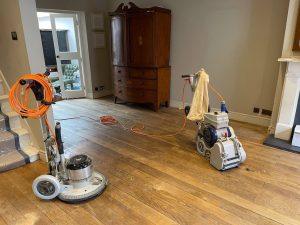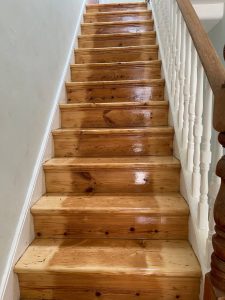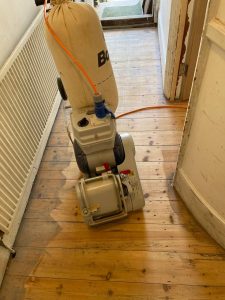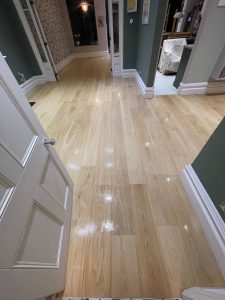
Floor sanding is a crucial process in maintaining the beauty and longevity of wooden floors. Over the years, the techniques and tools used in floor sanding have evolved significantly. Understanding the history and evolution of floor sanding techniques can provide valuable insights into the best practices used today. Here’s a look at how floor sanding has developed over time.
- Early Beginnings
Hand Sanding:
- In the early days, floor sanding was a labor-intensive process performed entirely by hand. Craftsmen used sandpaper, steel wool, and scrapers to smooth and finish wooden floors. This method was time-consuming and required significant skill and effort.
Natural Finishes:
- Early finishes were made from natural materials such as beeswax, linseed oil, and shellac. These finishes provided a protective layer but required frequent reapplication and maintenance.
- Industrial Revolution and Mechanisation
Introduction of Machines:
- The Industrial Revolution brought significant advancements, including the introduction of mechanised sanding tools. The first floor sanding machines appeared in the late 19th and early 20th centuries, revolutionising the process. These early machines were large, heavy, and often difficult to use, but they significantly reduced the time and labor required for sanding.
Electric Sanders:
- The development of electric floor sanders in the mid-20th century further streamlined the sanding process. These machines, powered by electricity, were more efficient and user-friendly. They allowed for more consistent results and made floor sanding more accessible to a wider range of professionals and DIY enthusiasts.
- Modern Techniques and Equipment
Belt Sanders and Drum Sanders:
- Today, belt sanders and drum sanders are the primary tools used for floor sanding. These machines use rotating belts or drums covered with abrasive materials to sand the floor surface evenly. They are highly effective at removing old finishes, stains, and scratches.
Edge Sanders:
- To complement belt and drum sanders, edge sanders are used for sanding areas close to walls and in corners. These smaller, more maneuverable machines ensure that every part of the floor is sanded thoroughly.
Dust Collection Systems:
- Modern sanding equipment is often equipped with dust collection systems that capture the majority of the dust produced during sanding. This innovation has significantly improved the cleanliness of the process and reduced health risks associated with inhaling wood dust.
- Advancements in Finishing Products
Polyurethane Finishes:
- The introduction of polyurethane finishes in the mid-20th century marked a significant advancement in floor finishing. These finishes are durable, water-resistant, and provide a long-lasting protective layer. They come in both oil-based and water-based formulations, offering various options for homeowners and professionals.
Eco-Friendly Options:
- In recent years, there has been a growing demand for eco-friendly finishes. Low-VOC (volatile organic compound) and water-based finishes are now widely available, providing effective protection while being safer for the environment and indoor air quality.
- Technological Innovations
Laser-Guided Sanders:
- Some modern floor sanders are equipped with laser guides to ensure precise sanding. These advanced machines help operators achieve a uniform finish and avoid over-sanding specific areas.
Automated Sanding Systems:
- The latest innovations include automated sanding systems that can be programmed to sand large areas with minimal human intervention. These systems are particularly useful in commercial settings where large floor spaces need to be sanded quickly and efficiently.
Conclusion
The history and evolution of floor sanding techniques reflect the broader trends in technology and innovation. From the manual labor-intensive methods of the past to the advanced, efficient systems of today, floor sanding has come a long way. Understanding these developments not only highlights the importance of choosing the right tools and finishes but also underscores the value of professional expertise in achieving the best results.
For homeowners in London, staying informed about the latest advancements in floor sanding ensures that you can maintain your wooden floors with the highest standards of care and sustainability. Whether you’re preserving a historic property or updating a modern home, leveraging the best practices in floor sanding can enhance the beauty and longevity of your floors.







Floor Sanding for Rental Properties: Maintenance Tips
Floor Sanding for Rental Properties: Maintenance Tips Ensure Your Rental Floors Remain Beautiful and[Read more...]
Understanding Grit Sequences in Floor Sanding
Understanding Grit Sequences in Floor Sanding Achieving the Perfect Finish for Your London Home[Read more...]
How to Prepare Your Home for Floor Sanding
Preparing your home for floor sanding is a crucial step to ensure a smooth and[Read more...]
How to Maintain the Shine on Your Sanded Floors
How to Maintain the Shine on Your Sanded Floors Expert Tips for Keeping Your[Read more...]
Floor sanding and renovation and installation services in Hertfordshire
Hertfordshire: A County of Scenic Beauty and Modern Living Hertfordshire is a picturesque county in[Read more...]
Floor Sanding FAQs: Everything You Need to Know
Floor sanding is a popular method for rejuvenating wooden floors, but it often comes with[Read more...]
The Importance of Grain Direction in Floor Sanding
The Importance of Grain Direction in Floor Sanding When it comes to floor sanding,[Read more...]
The Importance of Professional Inspections Before Sanding
The Importance of Professional Inspections Before Sanding Ensure your London home is prepared for[Read more...]
The Future of Floor Sanding: Emerging Trends and Technologies
The Future of Floor Sanding: Emerging Trends and Technologies Discover How Advancements Are Shaping[Read more...]
Stair sanding
[Read more...]